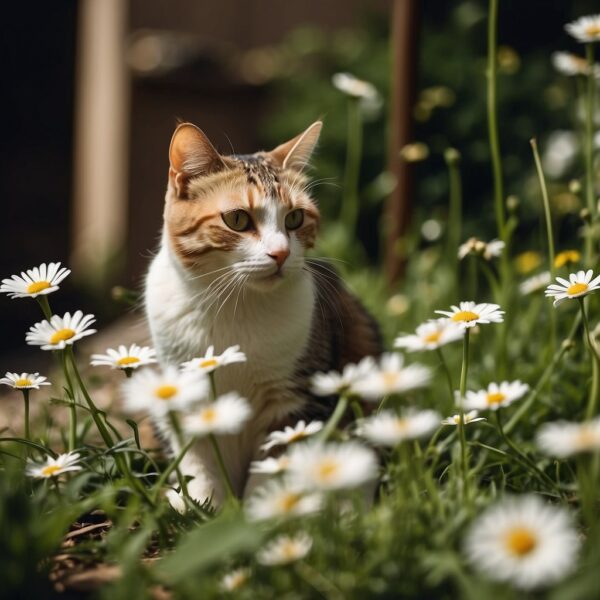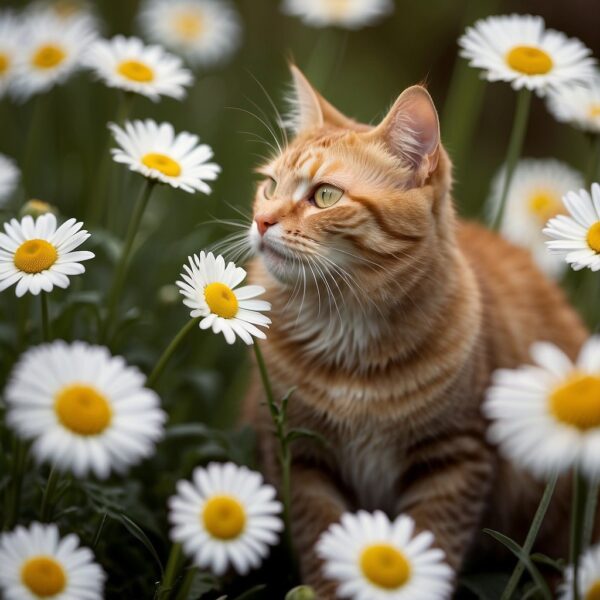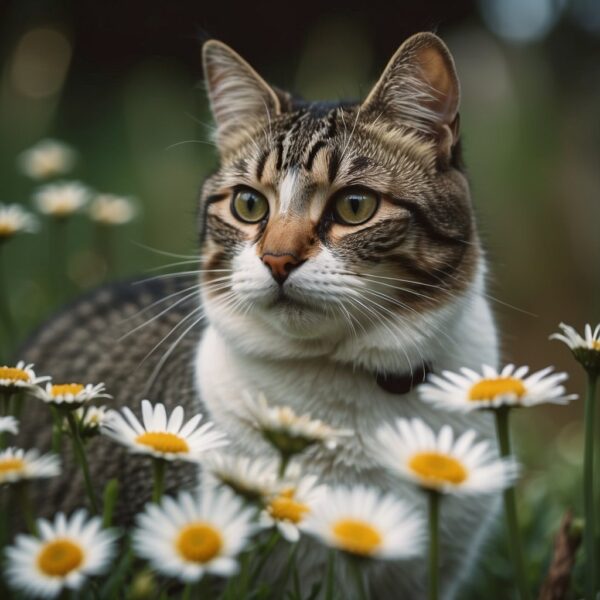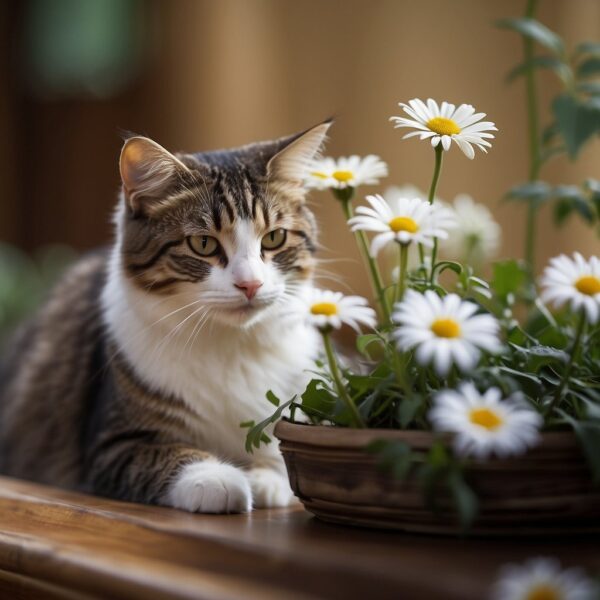
Daisies Are Toxic to Cats: Understanding the Risks
While they may appear as charming additions to gardens and bouquets, daisies can pose a serious health risk to cats. These common flowers, which include a variety of species such as the Chrysanthemum, are poisonous to our cat companions. If ingested, daisies can cause a range of unpleasant to severe symptoms in cats, stemming from the various toxic compounds they contain.
Recognizing the signs of daisy poisoning in cats is crucial for cat parents to provide timely care. Symptoms can include vomiting, diarrhea, hyper-salivation, and lack of coordination. In such instances, it is imperative for cat parents to respond swiftly by seeking veterinary attention to mitigate the risks and ensure their cat’s well-being.
Key Takeaways
- Daisies are toxic to cats and can cause a range of symptoms.
- Immediate veterinary care is critical if a cat ingests daisies.
- To protect cats, it’s best to prevent access to daisies and other toxic plants.
Overview of Daisy Toxicity in Cats
Daisies, while aesthetically pleasing, contain toxins harmful to cats. It is important for cat parents to recognize which species pose a risk and what toxic elements these plants carry.
What Makes Daisies poisonous to Cats
The Asteraceae family, to which daisies belong, includes several species that are poisonous to cats. They contain multiple poisonous compounds such as lactones, pyrethrin, and sesquiterpene. Specifically,
- Lactones and pyrethrins: These disrupt the nervous system in felines, causing symptoms such as trembling or seizures.
- Sesquiterpene lactones: Found throughout the plant, these can cause skin irritation and gastrointestinal issues when ingested.
Common Toxic Species Related to Daisies
Not all members of the Asteraceae family are harmful, but some common daisy species that are toxic include:
- Chrysanthemum spp.: These plants contain lactones and pyrethrin which are particularly toxic.
- Gerbera jamesonii: An exception within the daisy family, this species is generally recognized as non-toxic to both cats and dogs and can be safely kept around them.
Understanding which specific daisy plants are poisonous to cats helps prevent accidental poisonings and ensures a safe environment for feline companions.

Recognizing Symptoms of Daisy Poisoning in cats
When cats ingest daisies, they may exhibit a range of clinical signs that can affect various systems within their body. Prompt identification of these symptoms is crucial for the cat’s health.
Gastrointestinal Signs
Cats that have been poisoned by daisies may display several gastrointestinal symptoms. Two of the most common are:
- Vomiting: Cats may vomit, which in severe cases, can contain blood denoting serious irritation or damage to the stomach lining.
- Diarrhea: Frequent loose or watery bowel movements are another indicator of daisy poisoning and can lead to dehydration if not addressed quickly.
Dermatological Responses
Poisoning from daisies can lead to skin issues exhibiting as:
- Skin Irritation: Look for signs of dermatitis, such as redness, rash, or inflammation, which indicates a localized allergic response.
- Excessive Salivation: Although not a skin condition, excessive drooling can occur concurrently due to irritation within the mouth.
Neurological Manifestations
Neurological effects of a cat poisoned by daisies can be severe and require immediate attention. Symptoms include:
- Loss of Coordination (Incoordination): Cats may struggle with balance and movement.
- Tremors or Seizures: These are serious signs, reflecting neurological impact, and may manifest alongside other symptoms such as difficulty breathing or foam at the mouth.
What to Do If Your Cat eats poisonous Daisies
If a cat consumes daisies, prompt action is required to address potential toxicity. Cat parents should be aware of immediate steps to take and the necessity of professional veterinary treatment.
Immediate Steps for cat parents After Cat Eats Daisies
Upon discovering that a cat has eaten poisonous daisies, it is crucial to remove any remaining plant material from the cat’s reach. Guardians should then monitor the cat for signs of gastrointestinal upset, which could indicate poisoning. It’s recommended to offer water to the cat to help dilute the toxins.
- Symptom Observation: Closely watch for abnormal signs such as vomiting, diarrhea, excessive salivation, or skin irritation.
- Wrapping and Carrying: If the cat is lethargic or uncoordinated, gently wrap it in a towel to prevent injury before transport.
Professional Veterinary Treatment
Cat parents should contact a veterinarian immediately after cat eats poisonous daisies. A professional will give informed advice and, if required, may suggest bringing the cat in for treatment.
- Initial Contact: Share details about the incident with the vet, including the amount and part of the plant ingested if known.
- Treatment Procedures:
- Fluid Therapy: To manage dehydration and support kidney function, intravenous or subcutaneous fluids may be administered.
- Medications: The vet might prescribe medication to alleviate symptoms or protect the gastrointestinal tract.
Guardians can locate the nearest veterinarian or emergency clinic using the resources provided by the American Society for the Prevention of Cruelty to Animals (ASPCA) if their usual veterinarian is unavailable.

How to Prevent Daisy Poisoning
Protecting cats from the potential hazards of daisy poisoning involves discerning between harmful and harmless flora, as well as ensuring the environment is devoid of toxic plants.
Identifying Non-Toxic Flowers
Cat parents are advised to consult reliable sources such as the American Society for the Prevention of Cruelty to Animals (ASPCA) to distinguish non-toxic flowers from those that pose a risk. Non-hazardous alternatives to daisies include:
- Sunflowers: These are safe and can add brightness to a home without risking feline health.
- Snapdragons: A vibrant choice that poses no harm to cats.
- Roses: While thorns can cause physical injury, the plant itself is non-toxic to pets.
- Orchids: A diverse family of flowers considered safe for cats.
Guardians should remain vigilant, as toxic flowers like lilies, chrysanthemums, and lily of the valley can be dangerous if ingested by cats.
Creating a Safe Environment
Creating a safe living space for cats means attentively regulating the types of plants and flowers within reach. Here are steps to support a secure environment:
- Remove Toxic Plants: Ensure flowers such as lilies, daisies, and chrysanthemums are not accessible to cats in any indoor or outdoor setting.
- Secure Flower Arrangements: When displaying non-toxic flowers, position them where cats cannot reach them to avoid any potential ingestion.
- Regular Monitoring: Frequently examine your garden or home for the appearance of any plants that may endanger your pet.
- Educate Household Members: Share knowledge about toxic and non-toxic plants with everyone in the home to safeguard your pets collectively.
By adopting these practices, cat parents can substantially lower the risk of daisy poisoning and maintain a secure and enjoyable environment for their cats.

Understanding the Chemistry of Daisy Toxins
Daisies contain chemical compounds that can be harmful to cats when ingested. These compounds are known for their effects on the feline nervous system and digestive tract.
Chemical Compounds in Toxic Daisies
Toxic daisies have a few key chemical compounds that present risks to cats:
- Pyrethrins: These are natural insecticides found in various species of the chrysanthemum family, such as daisies. Pyrethrins are neurotoxins affecting insects primarily but can be toxic to cats if ingested in large quantities.
- Lactones: A group of chemicals known for their bitter taste and potential to cause irritation and harm if consumed. Some lactones function as a defense mechanism for plants.
- Sesquiterpene: Another constituent of the daisy family, these compounds can cause skin irritation and gastrointestinal issues in cats.
Effects on the Cat’s Nervous System
Pyrethrins and lactones act on the cat’s nervous system through different pathways. They are classified as neurotoxins and can cause:
- Nervous system: Overstimulation leading to symptoms like tremors, seizures, or hyper-excitability. Cats may also experience weakness or depression of the central nervous system if exposed to high doses.
- Digestive tract: These chemicals can lead to vomiting, diarrhea, and in severe cases, internal bleeding, evidenced by blood in the cat’s feces or vomit.
It is essential for cat parents to recognize these risks and ensure daisies are kept out of reach of their feline companions.
Other Plants That Are Harmful to Cats
While daisies can cause discomfort, it is important for cat parentss to be aware of other plants that pose greater risks to feline health.
Common Houseplants and Outdoor Plants to Avoid
Several plants commonly found in and around homes are toxic to cats. Here is a non-exhaustive list:
- Chrysanthemum species (Chrysanthemums): These contain substances like pyrethrins that can lead to vomiting, diarrhea, and incoordination.
- Saponin-containing plants (such as holly, yucca, and ivy): Saponins can cause vomiting, diarrhea, and drooling if ingested.
- Aster family: Plants in this family, like the chrysanthemum, may cause gastrointestinal upset in cats.
- Chamomile (Anthemis nobilis): Symptoms of chamomile poisoning might include vomiting, diarrhea, dermatitis, and anorexia.
- Lantana (Lantana camara): Ingestion can result in liver failure, seizures, and possible death.
- Autumn Crocus (Colchicum autumnale): All parts of this plant are highly toxic and can lead to severe vomiting, gastrointestinal bleeding, liver and kidney damage, and respiratory failure.
- Tulip/Narcissus bulbs: These can cause intense gastrointestinal irritation, drooling, loss of appetite, depression of the central nervous system, convulsions, and cardiac abnormalities.
- Dieffenbachia (Dumb canes): This plant can cause oral irritation, intense burning and irritation of the mouth, lips, tongue, excessive drooling, vomiting, and difficulty swallowing.
Cat parents should ensure that any plants brought into the home are non-toxic to cats. It’s also advisable to monitor cats’ behavior outdoors where they may encounter toxic plants. If poisoning is suspected, immediate veterinary attention is crucial.

Frequently Asked Questions
In this section, we address common concerns about the potential toxicity of daisies to cats, including the identification of harmful varieties, signs of poisoning, and steps for prevention and response.
Which varieties of daisies are harmful to cats?
Several varieties of daisies, including the common Shasta daisy are considered toxic to cats. It is important to recognize and differentiate between nontoxic and toxic daisy species to ensure the safety of feline pets.
Can exposure to daisies cause illness in cats?
Yes, exposure to certain daisy varieties can cause illness in cats. Ingesting even a small amount of these plants can lead to toxic reactions and warrant immediate veterinary attention.
What are the symptoms of daisy poisoning in cats?
The symptoms of daisy poisoning in cats may include vomiting, diarrhea, hyper-salivation, dermatitis, and a lack of coordination. If a cat displays any of these symptoms after contact with daisies, it is crucial to seek veterinary care.
How should a cat parent respond if their cat ingests daisies?
If a cat ingests daisies, the owner should immediately remove any plant remnants from the cat’s mouth and contact a veterinarian or a poison control center. Prompt action can reduce the risk of severe poisoning.
Are there any safe daisy-like flowers for cats?
Some flowers that resemble daisies, such as the camomile, are safe for cats. However, guardians should verify the safety of each plant with a reliable resource or consult with their veterinarian.
What precautions can cat parents take to prevent daisy toxicity?
Cat parents can prevent daisy toxicity by keeping toxic daisies out of their home and garden. Additionally, educating oneself on plant toxicity and monitoring cats’ outdoor activities can help minimize risks.